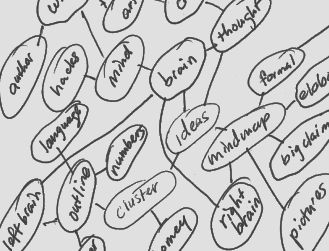I’m not a big fan of mind mapping, though I concede that it does have its uses. Recently, I learned of a different approach to brainstorming that seems both more practical and better grounded in the way the mind works than traditional, Buzan-style mind mapping. This approach, called the Rico Cluster after its developer, Dr. Gabrielle Rico, focuses on the creation of a “web” of related and interconnected ideas, rather than radiating out from a central concept, and is intended to leverage the brain’s normal processes of communication between the right and left hemispheres. The idea is to work towards a kind of “critical mass”, where the language- and process-oriented left brain takes over from the visual- and pattern-oriented left.
What is a Rico Cluster?
Rico clustering is a brainstorming tool that emphasizes the connection between left-brain openness and connection-making and right-brain verbalization and ordering. Although it is intended primarily as a writing tool, it can also be applied to teaching — and Rico herself has written about its use as a therapeutic tool, as well.
Here’s the basic idea:
- Write a word in the middle of a sheet of paper.
- Circle it.
- Write down the first word or phrase that comes to mind and circle it.
- Draw a line connecting the second circle to the first.
- Repeat. As you write and circle new words and phrases, draw lines back to the last word, the central word, or other words that seem connected. Don’t worry about how they’re connected — the goal is to let your right-brain do its thing, which is to see patterns; later, the left-brain will take over and put the nature of those relationships into words.
- When you’ve filled the page, or just feel like you’ve done enough (a sign of what Rico calls a “felt-shift”), go back through what you’ve written down. Cross out words and phrases that seem irrelevant, and begin to impose some order by numbering individual bubbles or clusters. Here is where your right-brain is working in tandem with your left-brain, producing what is essentially an outline. At this point, you can either transfer your numbered clusters to a proper outline or simply begin writing in the order you’ve numbered the clusters.
By the time you’ve started reviewing your clusters, your brain has done much of the work of fleshing out your ideas; all that remains is to put these relationships into words, which is what your left-brain excels at.
The Rico cluster grabbed my attention because I’ve lately been thinking a lot about how to brainstorm alone and this seems to fit the bill. I suppose “regular” mind mapping would do the trick, but I was pretty put off by the extravagant claims made by mind-mapping advocate Tony Buzan; clustering seems much more down-to-earth and homey than Buzan’s elaborate, multi-colored, goal-oriented mind maps. Maybe that’s just me, and I’ve bought into mind mapping under a different name; so be it.
Rico Clusters as a Teaching Tool
While my interest is in clustering as a brainstorming-for-one tool, it is easily adapted to a group situation, where ideas are thrown out and jotted quickly on a whiteboard. What’s missing, though, is the patterning — someone needs to draw the lines that form the clusters.
A teacher or facilitator could do this, using the role of pattern-maker to subtly guide the discussion, but another option would be to have a student or, in a business setting, one of the brainstormers, take on this role, perhaps rotating and having a series of people draw in connecting lines. When the ideas start drying up (or the board is full) begin the process of sorting out and numbering ideas, with input from the group.
There is some evidence that brainstorming as a group is actually less effective than several people brainstorming individually and just combining their results, so I’m not sure I advocate this as an idea-generating tool. Instead, I see it as a way of helping a class draw lessons from a body of work — a book or play, a movie, a trip, or an experience. In a business setting, this might be a way to draw lessons out of a strategic failure, or develop new ways of applying existing processes.
Clustering as a Therapeutic Tool
Rico’s book Pain and Possibility: Writing Your Way through Personal Crisis suggests another use for clustering: using them to draw out unconscious sources of pain in the context of recovery and healing. While this is exactly the kind of extravagant claim I generally reject, it might be useful for other people so it at least deserves consideration. A feeling or source of pain is listed as the “seed” and ideas free-associated off of that. The process is akin to automatic writing, where the mind starts calling forth language and concepts without conscious filtering; hopefully we surprise ourselves with connections we hadn’t been aware of, or conflicts that we had carefully concealed from our conscious awareness.
Like I said, this isn’t the kind of thing I think generally works, but for some people this kind of emotional work proves very uplifting, so who am I to judge? For myself, I think I’ll stick with trying clustering to deal with the more mundane problem of generating and capturing writing ideas. If nothing else, it’s at least worth a try, especially if you’re the kind of person for whom traditional outlining is a real chore.













































